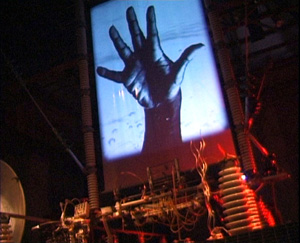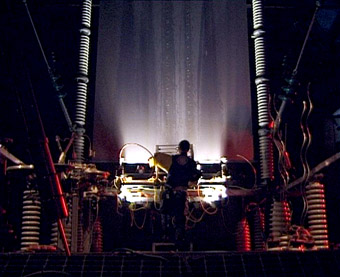Arterial Group: the big charge
Keith Gallasch

Barry Schwartz & The Arterial Group, ELEKTROSONIC INTERFERENCE
courtesy the artists
Barry Schwartz & The Arterial Group, ELEKTROSONIC INTERFERENCE
The huge, wide walls of the Brisbane Powerhouse Turbine Hall wrap around us, flooded with images moving slowly, vertically, the effect is vertiginous. In the centre of the hall digital images play on a large screen above a collection of bright metal sculptures standing just above water. A projection on another wall picks up artists and technicians as they move purposefully about the space. A choir appears on various levels delivering text in song, chatter, chirp and mutter. The recorded voice of an elderly one-time Powerhouse worker, Max Ham, intones the fun of working life (including his workers’ skiffle group, The 5 Kilowatts) and the horrors of a building then awash with asbestos and machines that chopped off fingers and limbs. A long row of artists and technicians sit at a bank of computers, lighting and sound desks. Centre stage is the American Barry Schwartz (electro-mechanical structures, RT#44) and, constellating about him, the Belgian Bastiaan Maris (chemo-acoustic installations), the Brisbane artists Andrew Kettle (sound) and Keith Armstrong (visual production) and others in their coveralls.
As the installation-performance slowly unfolds over the hour, sparks begin to fly, shooting out of the top of a condensor accompanied by shards of sound. Schwartz activates the sculptures. The stroking of a large metal disk yields eerily primal metallic groans. The artist lowers what looks like a huge, smoking turntable arm onto the same disk unleashing pure, massive cymbal-like tones. The pace of the work accelerates, the tone growing more ominous, the choir heralding something apocalyptic, Ham telling of death by electric shocks, death by asbestosis. Schwartz dons long, protective, insulated yellow sleeves and big gloves, dips them into water and turns to the big screen, now streaming with water. He strikes, igniting the water with balls of electricity that travel up and fade, as others climb higher and higher, each stroke ringing out like chorded bells heralding the end of time. Unlike the workers in the Powerhouse who were electrocuted and resuscitated or died, Schwartz is safe, transforming danger into awesome, if grim beauty.
In a key moment, a wiry tree sculpture (realised exquisitely as well in a digital version onscreen) is picked up, electrified and inverted by Schwartz—“The possibilities for radical enchantment are signified by an inverted wattle tree—resembling the Jewish inverted tree of life—which was part of the ceremonial initiation of young [Indigenous] men and was called kakka, meaning ‘something wonderful’” (program note).
To see a living installation on such a scale and of such ambition as Elektrosonic Interference in Australia is a very rare experience. Limited funds, short development periods, inadequate venues and scarce technical resources usually gravitate against the realisation of artistic visions of this kind. However, Brisbane’s Arterial Group have managed to find the collaborators, the financial support, goodwill and the venue with which to realise a major multimedia creation.
It’s hard to do justice to the scale of the work. There are other resonating layers. The site-specific response to the Powerhouse (built in the 20s to power Brisbane’s tram fleet) also includes the site’s environmental and Indigenous past, primarily found in writer Douglas Leonard’s text, scored by composer Stephen Leek and performed by The Australian Voices, and visually echoed in the projections on the Powerhouse walls, spelling out ‘Terra Nullius’. In antithesis to this oppressive notion, Leonard uses another local Indigenous word, Kore, denoting wonder. The text and composition, Kore, includes a litany of environmental riches:
eastern water dragon/saw-shelled tortoise/swamp snake/broad-palmed rocket frog/clicking froglet/echidna/chocolate bat/fawn-footed melomys/ferny azolla/spikerush grogbit/golden-lined whiting/bull rout/pacific-eyed rainbow fish/freshwater catfish/azure kingfisher/rainbow lorikeet/red-legged pademelon/rufous bettong sugar glider
These are spoken against sung lines: “They are coming back, the weeping bottle-brush, the broad-leafed apple, giant ironwood, white bean, black ti-tree, native holly, axe-handle wood…Kore, Kore, Kore, they are coming back,” and an invocation of Nguril, the Creator of the river, plains and creeks of the region.

Barry Schwartz & The Arterial Group, ELEKTROSONIC INTERFERENCE
courtesy the artists
Barry Schwartz & The Arterial Group, ELEKTROSONIC INTERFERENCE
Leonard has also constructed the sound text drawing on the oral histories of the multicultural Powerhouse workers, revealed in their terse natural poetry, their detached accounts of workplace accidents and management negligence, recollections of the Powerhouse cat, a river overflowing with fish, and pride in The 5 Kilowatts.
The cinematic dimension to the work is enveloping, entailing whole walls and screens, recorded and live projections. It provides a rich theatre of simultaneity, of choosing where to direct one’s gaze as the work unfolds.
For a creation of such ambition and textural complexity it’s not surprising that it didn’t always work or please everyone. Opening night appeared to be seriously under-rehearsed. For 20 minutes it looked like it wasn’t working at all, although there was a lot of flurried techy movement about the stage. The choir, even when miked, were often hard to hear above the soundtrack and the talkative audience—but when they were heard in their scored whispering, muttering, coughing and singing, they excelled. Lighting ranged from spectacular to inadequate—Schwartz was seriously underlit at crucial moments. A show that sets up such huge theatrical expectations has to go some way towards meeting them, even if it is an installation with its roots in the anti-theatrics of performance art.
For many who found the first 40 minutes sluggish and unfocused, all was forgiven in the last 20. For others the work was always unwieldy—too many layers, too many collaborators. Some had seen Schwartz perform overseas, describing his work as more complete, more coherent when more or less on his own. One viewer described him as a showman out of context in the preoccupations of his collaborators. Of course, the line between showman and artist is often a thin one in contemporary performance, and certainly Schwartz’s offering in Elektrosonic Interference was not as spectacular as some had hoped. Its beauty was rare and idiosyncratic and the meshing of water, electrical flow and spark and sound was often remarkable. But for the audience the work did require a special patience and attention under sometimes difficult circumstances—awkward production values, tiny program notes, an hour or more of standing, often crowded viewing. Apparently, subsequent performances were more focused and more satisfying.
Elektrosonic Interference needs to be rewarded for more than ambition. Australia can be a punishing place to work, off-the-cuff dismissal is de rigeur, failure to recognise achievement and potential is common, though a little less brutal than it has been. Works on the scale of Arterial’s vision (involving more than 70 artists, technicians, singers, volunteers) remain rare and are usually the province of overseas artists in shows we hear about, but rarely if ever see. The collaboration with Schwartz and Maris offered an opportunity to embark on such a venture. It is to be hoped that the Australian collaborators will carry this unique experience forward into new, equally ambitious projects.
It has been wearying in recent decades to see theatre company casts whittled down, performance ensembles disappear, feature films strangled by small budgets. No wonder Theft of Sita and Cloudstreet have been greeted so passionately—scale is integral to their power. Brisbane’s ELISION ensemble is another company working with installation as performance and across artforms. transmisi was performed in the Tennyson Powerhouse in 1999 for the Asia Pacific Triennial, Opening of the Mouth in the Midland Railway Workshop for the 1997 Perth Festival. IHOS Opera too operate on a rarely seen scale. Big is not always best, but unless Australian artists seek to experiment with scale, and are empowered to do so, we’ll continue to feel that something is missing.
Arterial Group-Barry Schwartz Collaboration, Elektrosonic Interference, director/performance artist Barry Schwartz; sculpture workshop/technical director Bastiaan Maris; concept development Douglas Leonard, Barry Schwartz, Therese Nolan-Brown; Turbine Hall, Brisbane Powerhouse, Sept 6-8
RealTime issue #45 Oct-Nov 2001 pg. 29






